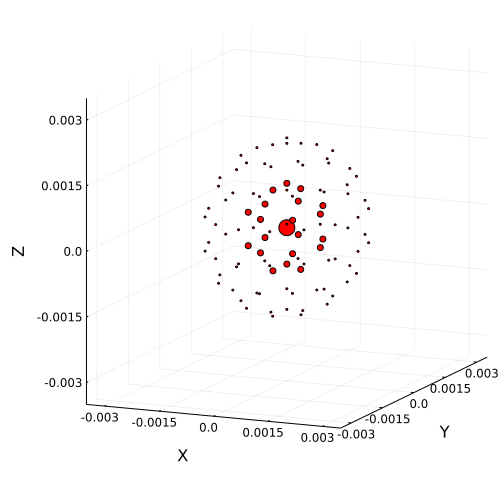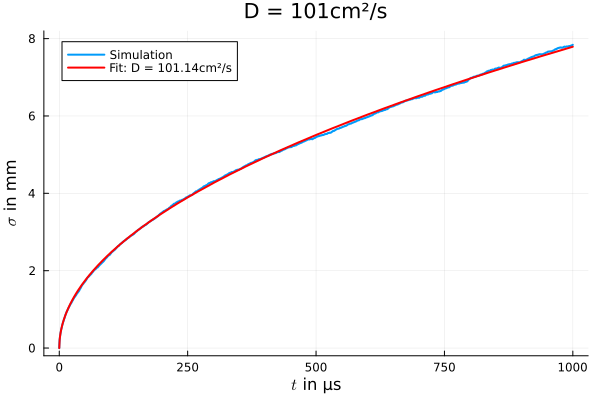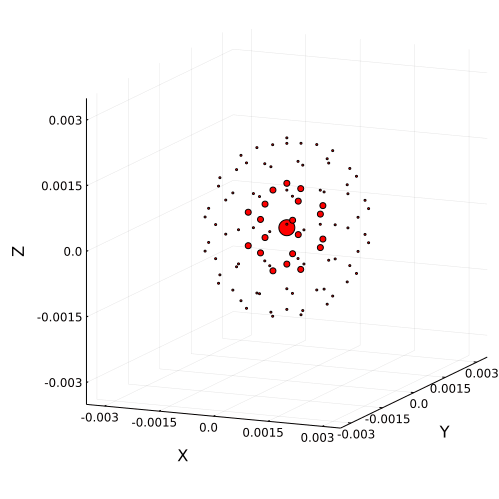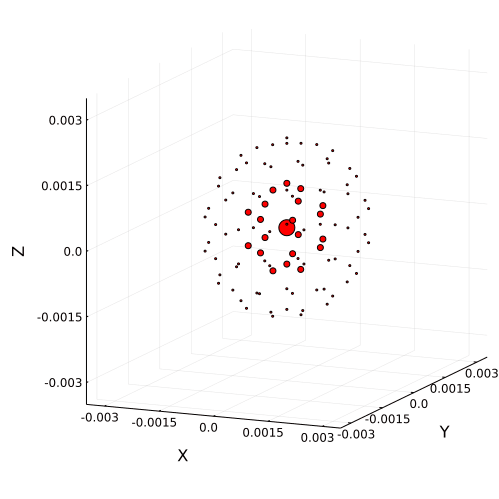Charge Drift
Charged particles in vacuum move along the electric field lines under Coulomb's force, $\vec{F} = q \vec{E}$, where $\vec{F}$ corresponds to the force experienced by the particle, $q$ is the charge of the particle and $\vec{E}$ is the electric field. Charged particles in vacuum would be continuously accelerated until approaching the speed of light (called ballistic transport). However, inside a material, scattering prevents this constant acceleration and leads to a constant drift velocity
\[v_{d} = \mu E,\]
where $v_{d}$ is the drift velocity, $\mu$ the mobility and $E$ the electric field strength.
The scattering with matter not only limits the absolute drift velocity, it might also deviate the trajectories from the electric field lines: e.g., in crystals, the principal axes orientation has an impact on the resulting drift trajectory. The influence of the scattering on the drift trajectories can be expressed by a 3x3 tensor, the so-called mobility tensor $\mu_{ij}$, which transforms the electric field, $E$, into the drift velocity, $v_{i}$:
\[v_{i} = \mu_{ij} \cdot E_{j}.\]
The mobility varies for different materials and depends also on other parameters such as temperature, impurity density and the electric field strength, as explained later.
Charge Drift Models
Electrons and holes have different mobilities, resulting in different drift velocities. There are several models for the mobility tensor of electrons and holes in certain materials. Right now, two models are implemented. The first one is a pseudo-drift model, the ElectricFieldChargeDriftModel, which just takes the electric field vectors as drift vectors, see section Electric Field Charge Drift Model. The second one, ADLChargeDriftModel, is a drift model for high purity germanium, see section ADL Charge Drift Model. However, the implementation of an own model is possible and explained in section Custom Charge Drift Model.
Electric Field Charge Drift Model
The ElectricFieldChargeDriftModel describes a system in which electrons and holes move along the electric field lines. In this case, the mobility is a scalar $\pm$ 1 m²/(Vs) ($+$ for holes, and $-$ for electrons), and thus, the velocity field has the same (or opposite) direction as the electric field. Even though this model does not describe reality, it is useful in some cases to use the electric field vectors as velocity vectors.
In order to set the ElectricFieldChargeDriftModel for the simulation, the precision type of the calculation T (Float32 or Float64) has to be given as an argument. Note that T has to be of the same precision type of the simulation:
T = SolidStateDetectors.get_precision_type(sim) # e.g. Float32
charge_drift_model = ElectricFieldChargeDriftModel(T)
sim.detector = SolidStateDetector(sim.detector, charge_drift_model)If no charge drift model is specified for the semiconductor of the detector in the configuration files, the default is ElectricFieldChargeDriftModel.
ADL Charge Drift Model
In high-purity germanium, the mobility cannot be expressed by a simple scalar quantity. Germanium has a cubic diamond lattice structure with $\langle$100$\rangle$, $\langle$110$\rangle$ and $\langle$111$\rangle$ as principal directions. Along these axes, the charge drift is parallel to the electric field. However, the longitudinal drift velocity, $v_{l}$, is not equally fast on the three axes.
On each axes, $v_{l}$ can be described through the parametrization proposed by D.M. Caughey and R.E. Thomas, which was later expanded by L. Mihailescu et al.:
\[v_l = \frac{\mu_0 E}{(1 + (E/E_0 )^{\beta})^{1/ \beta}} - \mu_{n} E.\]
The parameters $\mu_{0}$, $E_{0}$ and $\beta$ differ for electrons and holes, and $\mu_{n}$ is only relevant for electrons. These parameters were obtained by B. Bruyneel et al. by measuring the drift velocities of electrons and holes in the $\langle$100$\rangle$ and $\langle$111$\rangle$ directions in high purity germanium at a temperature of 78 K. These parameters are stored in a configuration file, "drift_velocity_config.yaml", located in <package_directory>/example/example_config_files/ADLChargeDriftModel. The configuration file is expressed as following:
model: ADLChargeDriftModel
phi110: -45°
material: HPGe
drift:
velocity:
model: Bruyneel2006
parameters:
e100:
mu0: 38609cm^2/(V*s)
beta: 0.805
E0: 511V/cm
mun: -171cm^2/(V*s)
e111:
mu0: 38536cm^2/(V*s)
beta: 0.641
E0: 538V/cm
mun: 510cm^2/(V*s)
h100:
mu0: 61824cm^2/(V*s)
beta: 0.942
E0: 185V/cm
h111:
mu0: 61215cm^2/(V*s)
beta: 0.662
E0: 182V/cmwhere the parameters are stored under the keys e100, e111, h100 and h111, in which e and h stand for electrons and holes, respectively, and 100 and 111, for the principal axes $\langle$100$\rangle$ and $\langle$111$\rangle$. By default, in SolidStateDetectors.jl the $\langle$001$\rangle$ axis is aligned with the Z-axis of the coordinate system of the simulation. The crystal orientation can be set through the phi110 parameter, where the $\langle$001$\rangle$ axis is still aligned with the Z-axis and the angle between the $\langle$110$\rangle$ principal direction of the crystal and the X-axis is given by phi110. Alternatively, the crystal orientation can be set by passing a rotation matrix that describes the rotation from the global coordinate system to the crystal orientation system.
If the electric field is not aligned with any of the crystal axes, the charge drift velocity is not necessarily aligned with the electric field. In the ADLChargeDriftModel, two models are implemented to describe the charge drift of electrons and holes between the axes. Detailed information about the charge drift models is provided in the papers from L. Mihailescu et al. for electrons and from B.Bruyneel et al. for holes. Find the detailed calculations and modifications from the publications as implemented in SolidStateDetectors.jl here.
In order to perform the calculation of the drift velocities, a configuration file containing the parametrization values like the "drift_velocity_config.yaml" (with Bruyneel's data or modified values), has to be passed as an argument to the ADLChargeDriftModel function. The precision of the the calculation T (Float32 or Float64) has to be given as a keyword T. Note that T has to be of the same type as the chosen in the simulation:
T = SolidStateDetectors.get_precision_type(sim) # e.g. Float32
charge_drift_model = ADLChargeDriftModel("<path_to_ADL_configuration_file>", T=T)
sim.detector = SolidStateDetector(sim.detector, charge_drift_model)The ÀDLChargeDriftModel can also be specified already in the configuration file as field charge_drift_model of the semiconductor of a detector, e.g.
detectors:
semiconductor:
# ...
charge_drift_model:
model: ADLChargeDriftModel
phi110: -0.785398 # in radians if no units are given
material: HPGe
drift: # ...or
detectors:
semiconductor:
# ...
charge_drift_model:
model: ADLChargeDriftModel
crystal_orientation:
X: 45° # crystal axes correspond to the global xyz coordinate system, rotated 45° around the x axis
material: HPGe
drift: # ...The charge_drift_model needs:
model: the name of the charge drift model, which in this case isADLChargeDriftModelphi110orcrystal_orientation: the description of the orientation of the crystal with respect to the global coordinate system. When usingphi110, the $\langle$001$\rangle$ axis is aligned with the globalzaxis andphi110describes the angle between the $\langle$110$\rangle$ axis and thexaxis in radians (counterclockwise, looking from the top). If the $\langle$001$\rangle$ axis is not aligned with thezaxis, a rotation matrix to transform the global coordinate system to the crystal axes system can be given.material(optional): the semiconductor material. If no material is given, thematerialof the semiconductor is taken by default.drift: the parameters needed to describe the longitudinal drift velocity along the $\langle$100$\rangle$ and $\langle$111$\rangle$ axes, see above.
The values from the default configuration file correspond to germanium at 78 K. Calculations of the drift velocities at other temperatures are also supported by the ADLChargeDriftModel. While experimental observations suggest that the charge mobilities of electrons and holes in the crystal are temperature dependent, the dependency law has not yet been established. Several models have been proposed to reproduce the experimental behavior, and some examples of them can be found in the directory <package_directory>/src/ChargeDriftModels/ADL/. The examples include a linear model, a Boltzmann model and a power-law model. To use these models in the calculation of the drift velocities, the corresponding configuration file, the temperature and the precision must be given to the function. As an example, in order to use the Boltzmann model at a temperature of 100 K:
T = SolidStateDetectors.get_precision_type(sim) # e.g. Float32
charge_drift_model = ADLChargeDriftModel("<path_to_drift_velocity_config_boltzmann.yaml>", T = T, temperature = 100)
sim.detector = SolidStateDetector(sim.detector, charge_drift_model)If no temperature is given as a parameter, the calculations will be performed at a default temperature of 78 K.
It should be noted that the correct model has not yet been identified, and the parameters inside these configuration files -besides the default ADL ones- are just educated guesses.
Custom Charge Drift Model
The user can implement and use his own drift model.
The first step is to define a struct for the model which is a subtype of SolidStateDetectors.AbstractChargeDriftModel:
using SolidStateDetectors
using SolidStateDetectors: SSDFloat, AbstractChargeDriftModel
using StaticArrays
struct CustomChargeDriftModel{T <: SSDFloat} <: AbstractChargeDriftModel{T}
# optional fields to parameterize the model
endThe second step is to define two methods (getVe for electrons and getVh for holes), which perform the transformation of an electric field vector, fv::SVector{3,T}, into a velocity vector. Note, that the vectors are in cartesian coordinates, independent of the coordinate system (cartesian or cylindrical) of the simulation.
function SolidStateDetectors.getVe(fv::SVector{3, T}, cdm::CustomChargeDriftModel)::SVector{3, T} where {T <: SSDFloat}
# arbitrary transformation of fv
return -fv
end
function SolidStateDetectors.getVh(fv::SVector{3, T}, cdm::CustomChargeDriftModel)::SVector{3, T} where {T <: SSDFloat}
# arbitrary transformation of fv
return fv
endThen, one can apply the model to the simulation:
T = SolidStateDetectors.get_precision_type(sim) # e.g. Float32
charge_drift_model = CustomChargeDriftModel{T}()
sim.detector = SolidStateDetector(sim.detector, charge_drift_model)Group Effects
The movement of electrons and holes is not only given by the forces resulting from external electric fields. In addition, diffusion and self-repulsion of the charge carriers can play a significant role when simulating drift paths. To simulate this, electron and holes cannot be described as single point-like charges anymore, but as charge clouds consisting of multiple point-like charges. SolidStateDetectors.jl offers different models for the Initial Charge Cloud Distribution. Right now, Diffusion and Self-Repulsion are implemented as experimental features.
Initial Charge Cloud Distribution
Electron and hole clouds can be easily constructed using NBodyChargeCloud. An NBodyChargeCloud consists of a center point charge, surrounded by shells of equally distributed point charges. SolidStateDetectors.jl provides two constructors for an NBodyChargeCloud, depending on how the charges in the shells should be distributed. For charge clouds consisting of few charges (less than around 50), the shells should consist of Platonic Solids, whereas for higher numbers of charges, the points in the shells should be Equally Distributed on a Regular Sphere.
Platonic Solids
One way of defining an NBodyChargeCloud is having a center point charge surrounded by shells with point charges on the vertices of platonic solids. For now, all shells will have the same number of charges and be oriented the same way.
center = CartesianPoint{T}([0,0,0])
energy = 1460u"keV"
nbcc = NBodyChargeCloud(center, energy)
plot(nbcc)Equally Distributed on a Regular Sphere
For an NBodyChargeCloud consisting of more than around 50 charges, the shells should consist of more than 20 point charges and the approach with using Platonic Solids for the shell structure might not be favored anymore. For this, a second algorithm was implemented that generates point charges equally distributed on the surface of a regular sphere. The approximate number of charges needs to be passed to the constructor of NBodyChargeCloud to use this method.
center = CartesianPoint{T}([0,0,0])
energy = 1460u"keV"
nbcc = NBodyChargeCloud(center, energy, 100)
plot(nbcc)Diffusion
Diffusion describes the random thermal motion of charge carriers. In SolidStateDetectors.jl, diffusion is simulated using a random walk algorithm. Diffusion is simulated using fixed-step vectors where the magnitude of the step vectors depends on the diffusion constant $D$ and the time steps $\Delta t$.
center = CartesianPoint{T}([0,0,0])
energy = 1460u"keV"
nbcc = NBodyChargeCloud(center, energy, 100)
evt = Event(nbcc)
simulate!(evt, sim, diffusion = true)
In the abscence of an external electric field, the size (standard deviation $\sigma$) of the charge cloud is expected to evolve with $\sigma = \sqrt{6 D t}$ (in three dimensions), where $t$ is the time. Thus, the diffusion constant determines the time evolution of the charge cloud size.
For an initial charge cloud of 1000 point charges, all located at the origin of the coordinate system, and a diffusion constant of $101\,\text{cm}^2\text{/s}$, the random walk algorithm results in the expected $\sqrt{t}$ dependence. A fit of $\sigma = \sqrt{6Dt}$ shows that the diffusion constant with which the charge cloud evolves matches the input value for $D$.

The diffusion constants for electrons and holes are stored in SolidStateDetectors.material_properties as De and Dh, respectively. For high-purity germanium, the diffusion constants for electrons and holes are reported to be $D_e = 101\,\text{cm}^2\text{/s}$ and $D_h = 49\,\text{cm}^2\text{/s}$. These values are the default values in SolidStateDetectors.material_properties:
SolidStateDetectors.material_properties[:HPGe]Electrons: 101 cm^2 s^-1
Holes: 49 cm^2 s^-1Values for De and Dh in SolidStateDetectors.material_properties can be given with or without units. If no units are passed, the values are interpreted as having the unit m$^2$/s.
Self-Repulsion
After the creation electron-hole pairs, both the electron and the hole clouds repel each other. The electric field of a point-charge, $q$, at a distance to the charge, $\vec{r}$, is given by
\[\vec{E} = \frac{1}{4\pi\epsilon_0\epsilon_r} \frac{q}{r^2} \vec{e}_r\]
SolidStateDetectors.jl does not account for attraction of electron and holes but only for repulsion of charge carriers of the same type. The determination of the electric field vector is calculated pair-wise for each pair of charge carriers.
center = CartesianPoint{T}([0,0,0])
energy = 1460u"keV"
nbcc = NBodyChargeCloud(center, energy, 100)
evt = Event(nbcc)
simulate!(evt, sim, self_repulsion = true)
Combination of Group Effects
Diffusion and Self-Repulsion can be simulated both at once to get the most realistic picture:
center = CartesianPoint{T}([0,0,0])
energy = 1460u"keV"
nbcc = NBodyChargeCloud(center, energy, 100)
evt = Event(nbcc)
simulate!(evt, sim, diffusion = true, self_repulsion = true)
However, be aware that simulations including group effects will result in significantly longer simulation times.